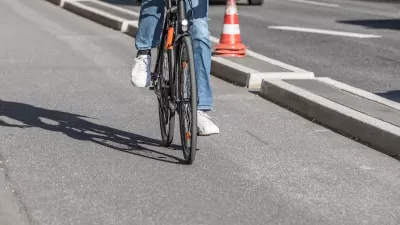It's no accident that the Cleveland suburb of Lakewood is one of the few school districts in Ohio without buses. Choices made by planners, parents, and school officials have preserved the inner-ring suburb as a “walking school district.”
The United States has seen a drastic decline in the percentage of children walking to school over the last five decades: from 50 percent in 1969 to 13 percent today. But in the Cleveland suburb of Lakewood (pop. 51,000), nearly all of the school district's 5,800 students gets to school by walking, biking, or getting a ride. The school system doesn't have any school buses. "It never has," writes Angie Schmitt.
"Over the years, as the school district has modernized and reduced the number of schools, Lakewood has consciously continued to make walking to school a high priority," she explains. "When Lakewood reduced the number of schools, it made sure they — especially the elementary schools — were spaced out to be close to as many students as possible. Rather than trading the older, walkable buildings for a more sprawling style, many of the historic school buildings underwent historic preservation treatments. That means no giant parking lots either."
FULL STORY: The Suburb Where Everybody Can Walk to School

Alabama: Trump Terminates Settlements for Black Communities Harmed By Raw Sewage
Trump deemed the landmark civil rights agreement “illegal DEI and environmental justice policy.”

Planetizen Federal Action Tracker
A weekly monitor of how Trump’s orders and actions are impacting planners and planning in America.

The 120 Year Old Tiny Home Villages That Sheltered San Francisco’s Earthquake Refugees
More than a century ago, San Francisco mobilized to house thousands of residents displaced by the 1906 earthquake. Could their strategy offer a model for the present?

LA’s Tree Emergency Goes Beyond Vandalism
After a vandal destroyed dozens of downtown LA trees, Mayor Karen Bass vowed to replace them. Days later, she slashed the city’s tree budget.

Sacramento Leads Nation With Bus-Mounted Bike Lane Enforcement Cameras
The city is the first to use its bus-mounted traffic enforcement system to cite drivers who park or drive in bike lanes.

Seattle Voters Approve Social Housing Referendum
Voters approved a corporate tax to fund the city’s housing authority despite an opposition campaign funded by Amazon and Microsoft.
Urban Design for Planners 1: Software Tools
This six-course series explores essential urban design concepts using open source software and equips planners with the tools they need to participate fully in the urban design process.
Planning for Universal Design
Learn the tools for implementing Universal Design in planning regulations.
Ada County Highway District
Clanton & Associates, Inc.
Jessamine County Fiscal Court
Institute for Housing and Urban Development Studies (IHS)
City of Grandview
Harvard GSD Executive Education
Toledo-Lucas County Plan Commissions
Salt Lake City
NYU Wagner Graduate School of Public Service




























